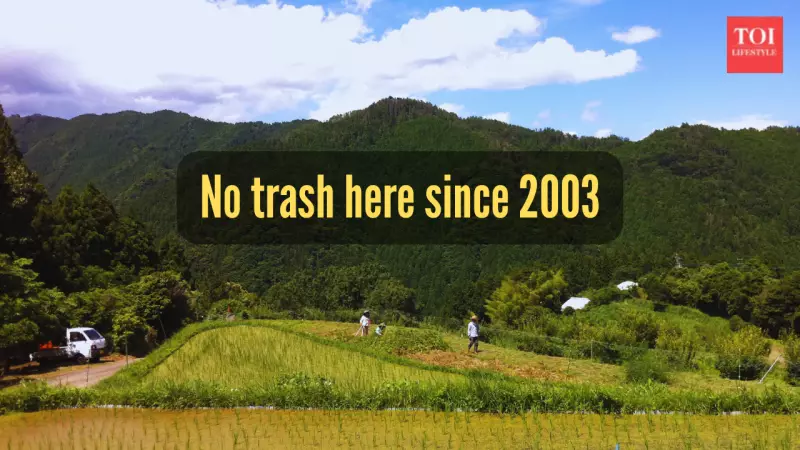
From Waste Mountains to Zero Waste: Kamikatsu's Inspiring Journey
Imagine living in a community where garbage doesn't accumulate in towering piles, where every resident meticulously sorts their waste into numerous categories, and where discarded items like clothing and kitchenware find new purpose instead of filling landfills. This vision has become reality in Kamikatsu, a small town nestled in the mountainous Shikoku Island of Japan, where approximately 1,500 residents have accomplished what many considered impossible – establishing a near zero-waste lifestyle.
This remarkable community has emerged as a global symbol demonstrating how human creativity and dedication can transform the waste crisis into a sustainable living model. Now consider India's overwhelming waste scenario, where more than 62 million tonnes of waste generate annually, with only 12 million tonnes receiving treatment. As India struggles with rapid urbanization and limited waste management infrastructure, Kamikatsu's achievement serves as a powerful inspiration that meaningful change can begin at the smallest scale.
The Birth of a Zero-Waste Revolution
According to Africancleancities.org, Kamikatsu's zero-waste journey started over two decades ago, though its foundations trace back even further. The town's incredible transformation replaced environmentally destructive open-air burning with a sustainable system based on reduce, reuse, and recycle principles, aiming for complete carbon neutrality. By 2021, the community reached an astonishing 80% recycling rate – four times higher than Japan's national average of just 20%.
Before World War II, life in this remote Japanese village primarily revolved around nature. People utilized bamboo, wood, and other biodegradable materials that left minimal waste behind. However, post-war industrialization dramatically altered this landscape. Synthetic plastics and disposable products became commonplace, and waste soon began accumulating at alarming rates.
Until the 1990s, Kamikatsu burned most garbage in open pits, filling the atmosphere with smoke and ash. The pivotal moment arrived in 1997 when new environmental standards mandated the closure of local incinerators. Constructing new incineration facilities proved too expensive for the small town, prompting officials to make a radical decision: generate less waste and recycle everything possible.
By 2001, Kamikatsu had implemented a separate at source system, requiring residents to bring sorted waste to a central collection facility. Two years later, it became Japan's first municipality to declare a zero-waste policy, inspired by American chemist Dr. Paul Connett, a pioneering figure in the global zero-waste movement.
Community-Driven Lifestyle Transformation
Kamikatsu's approach extends far beyond government directives – it has become a community-driven way of life. Residents meticulously sort their waste into 45 distinct categories at the local collection center. From newspapers neatly tied with twine to plastic bottles with removed caps and labels, every item gets cleaned, separated, and placed in the appropriate bin. Volunteers help ensure everything reaches its proper destination.
The Zero Waste Academy, established under Akira Sakano's leadership, forms the initiative's core. Operating under four guiding principles – Local, Low-cost, Low-impact, and Low-tech – the academy spreads awareness and educates both residents and visitors. Its mission: transform zero-waste living from a burden into shared civic pride.
Another innovative initiative emerged when the town launched the Kurukuru Shop, named after the Japanese word for circular. Residents donate unwanted clothes, dishes, or tools – and take home anything they need, completely free of charge. Approximately 80-90% of donated items get reused, proving that one person's trash genuinely can become another's treasure.
Kamikatsu also unveiled its iconic Zero Waste Centre, known as WHY. The circular wooden structure houses waste collection areas, educational facilities, and even a hotel where visitors can experience zero-waste living firsthand. The town's recycling rate has soared beyond 80%, significantly exceeding Japan's national average of 20%.
Overcoming Challenges and Global Lessons
The transformation journey presented significant challenges. Initially, many residents resisted sorting trash into numerous categories, finding the process time-consuming and confusing. However, through community meetings, workshops, and consistent support, the system gradually became second nature. Today, Kamikatsu's residents take profound pride in their planetary contributions.
The town acknowledges it hasn't achieved absolute zero waste. Certain items like leather shoes, diapers, or sanitary products remain non-recyclable and must be sent to incinerators outside the village. Recognizing this limitation, the local government launched a new zero-waste declaration for 2030, focusing on building a circular economy through collaborations with businesses and research institutions.
The fundamental lesson remains clear: waste management transcends mere recycling – it requires rethinking consumption itself. Kamikatsu encourages residents to refuse single-use plastics and rewards consistent waste reduction with community points redeemable for goods.
Kamikatsu's efforts have attracted global attention. Visitors from across Japan and worldwide come to study its system and explore adaptation possibilities elsewhere. Some locals admit the town's small population facilitates management, but the core principles – community involvement, segregation at source, and education – remain universally applicable.
For India, where landfills overflow and waste management stays fragmented, Kamikatsu offers genuine hope. The Japanese town's success relies not on advanced technology but on collective responsibility – something even megacities can cultivate through awareness, participation, and local innovation.
Kamikatsu may be small in size, but its vision proves immense. It reminds us that sustainability begins not with sweeping government reforms but with simple, daily choices – washing plastic bottles before recycling, reusing whatever possible, and refusing what we don't truly need.





